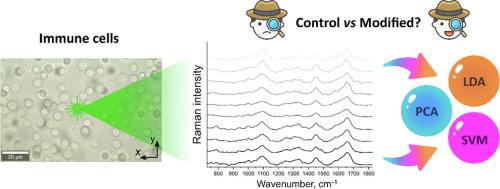Spectrochimica Acta Part A: Molecular and Biomolecular Spectroscopy ( IF 4.3 ) Pub Date : 2021-02-03 , DOI: 10.1016/j.saa.2021.119534 Chima Robert , Julia Tsiampali , Sara J. Fraser-Miller , Silke Neumann , Donata Maciaczyk , Sarah L. Young , Jaroslaw Maciaczyk , Keith C. Gordon

|
Raman spectroscopy (RS) has been used as a powerful diagnostic and non-invasive tool in cancer diagnosis as well as in discrimination of cancer and immune cells. In this study RS in combination with chemometrics was applied to cellular Raman spectral data to distinguish the phenotype of T-cells and monocytes after incubation with media conditioned by glioblastoma stem-cells (GSCs) showing different molecular background. For this purpose, genetic modulations of epithelial-to-mesenchymal transition (EMT) process and expression of immunomodulator CD73 were introduced. Principal component analysis of the Raman spectral data showed that T-cells and monocytes incubated with tumour-conditioned media (TCMs) of GSCs with inhibited EMT activator ZEB1 or CD73 formed distinct clusters compared to controls highlighting their differences. Further discriminatory analysis performed using linear discriminant analysis (LDA) and support vector machine classification (SVM), yielded sensitivities and specificities of over 70 and 67% respectively upon validation against an independent test set. Supporting those results, flow cytometric analysis was performed to test the influence of TCMs on cytokine profile of T-cells and monocytes. We found that ZEB1 and CD73 influence T-cell and monocyte phenotype and promote monocyte differentiation into a population of mixed pro- and anti-tumorigenic macrophages (MΦs) and dendritic cells (DCs) respectively. In conclusion, Raman spectroscopy in combination with chemometrics enabled tracking T-cells and monocytes.
中文翻译:

结合拉曼光谱法和化学计量学对胶质母细胞瘤的免疫原性进行分子监测
拉曼光谱仪(RS)在癌症诊断以及对癌症和免疫细胞的鉴别中已被用作强大的诊断和非侵入性工具。在这项研究中,将RS与化学计量学相结合,应用于细胞拉曼光谱数据,以区分T细胞和单核细胞的表型,然后与显示不同分子背景的胶质母细胞瘤干细胞(GSC)调节的培养基一起培养。为了这个目的,引入了上皮到间充质转化(EMT)过程的遗传调节和免疫调节剂CD73的表达。拉曼光谱数据的主成分分析表明,与具有抑制的EMT激活剂ZEB1或CD73的GSC的肿瘤条件培养基(TCM)一起温育的T细胞和单核细胞与对照组相比形成了不同的簇,从而突出了它们的差异。使用线性判别分析(LDA)和支持向量机分类(SVM)进行的进一步判别分析在针对独立测试集进行验证后,分别产生了70%和67%以上的敏感性和特异性。支持这些结果的是,进行了流式细胞仪分析以测试中药对T细胞和单核细胞的细胞因子谱的影响。我们发现ZEB1和CD73影响T细胞和单核细胞的表型,并促进单核细胞分化成混合的亲和抗肿瘤巨噬细胞(MΦs)和树突状细胞(DC)的人口。总之,拉曼光谱结合化学计量学可以追踪T细胞和单核细胞。经过独立测试集验证后,其灵敏度和特异性分别超过70%和67%。支持这些结果的是,进行了流式细胞术分析以测试中药对T细胞和单核细胞的细胞因子谱的影响。我们发现ZEB1和CD73影响T细胞和单核细胞的表型,并促进单核细胞分化成混合的亲和致瘤性巨噬细胞(MΦs)和树突状细胞(DC)的人口。总之,拉曼光谱结合化学计量学可以追踪T细胞和单核细胞。经过独立测试集验证后,其灵敏度和特异性分别超过70%和67%。支持这些结果的是,进行了流式细胞术分析以测试中药对T细胞和单核细胞的细胞因子谱的影响。我们发现ZEB1和CD73影响T细胞和单核细胞的表型,并促进单核细胞分化成混合的亲和抗肿瘤巨噬细胞(MΦs)和树突状细胞(DC)的人口。总之,拉曼光谱结合化学计量学可以追踪T细胞和单核细胞。我们发现ZEB1和CD73影响T细胞和单核细胞的表型,并促进单核细胞分化成混合的亲和抗肿瘤巨噬细胞(MΦs)和树突状细胞(DC)的人口。总之,拉曼光谱结合化学计量学可以追踪T细胞和单核细胞。我们发现ZEB1和CD73影响T细胞和单核细胞的表型,并促进单核细胞分化成混合的亲和抗肿瘤巨噬细胞(MΦs)和树突状细胞(DC)的人口。总之,拉曼光谱结合化学计量学可以追踪T细胞和单核细胞。











































 京公网安备 11010802027423号
京公网安备 11010802027423号